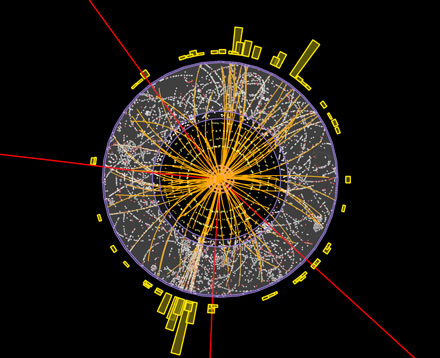Acercándonos al LHC
Por qué las partículas tienen masa? Por qué tienen las masas que tienen? Por qué hay tales diferencias de masas entre unas y otras?
El Modelo Estándar describe todo lo que nos sabemos sobre los más pequeños compoñentes de la materia y es la teoría más exacta desarrollada en cualquier campo de la Física. Sin embargo,sin la partícula Higgs no tiene sentido.
Más abajo introduciremos una analogía para ayudar a comprender el significado del mecanismo de HIggs.
En efecto, el modelo estándar tiene un aspecto no trivial que es que ciertos bosones intermediarios de las interacciones (W+, W -, Z0) tienen masa, y los otros (foton y gluones) no tienen.
Esto se explica introduciendo, "a mano", un campo escalar, cuyo minimo de energía no corresponde al campo nulo (como ocurre para el resto de los campos). Esto produce una "ruptura espontanea de la simetría", que hace que estos bosones y los fermiones, acoplados al campo escalar adquieran masa (al menos a energias bajas). Por los estudios teóricos en este campo, el físico estadounidense de origen japonés Yoichiro Nambu fue reconocido con elPremio Nobel de Física de 2008 junto a los japoneses Makoto Kobayashi y Toshihide Maskawa.
Si esto es cierto, el campo escalar podría efectuar "oscilaciones" en torno al valor minimo, que se manifestarian como la particula denominada Boson de Higgs.
|
En los años 60 del S.XX, independientemente, Peter Higgs, Francois Englert, Robert Brout, Gerald Guralnik, Dick Hagen y Tom Kibble, propusieron precisamente, que el universo estaba lleno de un campo más tarde llamado Campo de HIGGS. Otros físicos también colaboraron en este asunto, lo que va a complicar mucho una posible concecesión del Premio Nobel por esta cuestión. Como ya se ha comentado, las interacciones de las partículas con este campo provoca que adquieran masa. Podemos pues imaginar el espacio lleno de estas partículas virtuales (bosones de Higgs) que al interaccionar con las demás partículas provocan en ellas "dicficultade" para moverse. Es decir, las partículas adquieren inercia y por tanto masa. A más interacción con el campo Higgs más masa. Por ejemplo, los fotones no interaccionan con ese campo mientras que los quarks "top " lo hacen muy intensamente. |
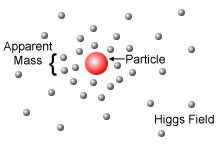 |
Siguiendo una analogía del US-LHC Communications Group, podemos imaginar a los electrones o neutrinos corriendo con "soltura" en una calle normal, sus primos pesados, los muones, haciéndolo con más resistencia, como si intentasen correr dentro de una piscina con agua, y finalmente, las partículas más pesadas, los quarks top, tratando de avanzar en una piscina de melaza.
Más adelante veremos unha analogía para entender mejor como las partículas adquieren masa en el campo de Higgs.
Más sobre el bosón de Higgs.
|
ATLAS y CMS son detectores de propósito general designados para "ver" un amplio rango de partículas y fenómenos poducidos en las colisións en el LHC. En 2012-13 un bosón de Higgs, con una masa de 125 GeV, fue descubierto a partir del análises combinado de datos obtenidos en estos dos detectores. 2000 físicos de 35 países participaron en el análsis de los datos registrados por estos dos complejos detectores. Ahora siguen trabajando con los datos ya registrados, y seguirán con los nuevos, para afinar los resultados y acercarse a otras zonas de la Física más allá del Modelo Estándar. En abril de 2024, la CMS collaboration dió a conocer públicamente la combinación de medidas del detector CMS que contribuyeron a establecer el descubrimiento del bosón de Higgs en 2012. |
Bosón de Higgs decayendo en 4 muones en ATLAS. |
El evento anterior un poco más en detalle:
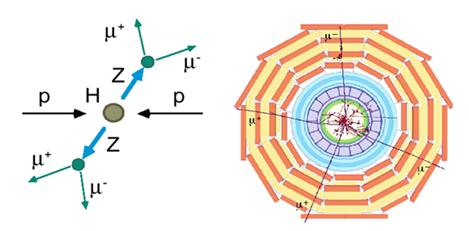
Este evento es consistente con dos partículas Z decayendo en dos muones cada una. Pero este evento puede producirse en procesos do Modelo Estándar que no implican la creación de un bosón de Higgs. Por tanto muchos eventos deben ser analizados para saber si se trata o no de una señal procedente de la producción de una partícula de Higgs.
|
A la derecha podemos ver una recreación de la interacción de dos gluones en el instante de la colisión de dos protones del LHC, produciéndose un bosón Higgs, un quark t y un antiquark t. Estas tres partículas decaen en una combinación de otros quarks y leptones muy particular que es muy difícil que se den desde otros procesos. Recogiendo suficientes evidencias de señales como ésta es coimo las colaboraciones ATLAS y CMS hacen descubrimientos como el del bosón de Higgs. |
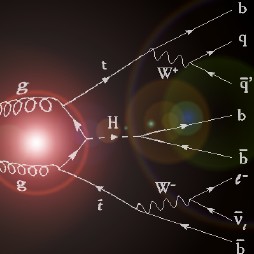 |
Medidas muy precisas con la interacción electrodébil apuntaban la existencia dun Higgs ligero. El experimento LEP2 descartó masas de Higgs por debajo de 115 GeV /c2. El rango para la masa del bosón de Higgs predicho por el Modelo Estándar empleado por los experimentos del LHC estaba en 114-600 GeV/c2 .
Los experimentos del Tevatron excluyeron la región de 158 a 174 GeV /c2 . Resultados de ATLAS y CMS, presentados en la Biennial Lepton-Photon Conference en Mumbai (India) Agosto 2011, muestraron también que la región de masas de 145 a 466 GeV /c2 están excluidas, con un 95 por ciento de certeza.
Por tanto, la región preferente abarcaba valores entre 115 y 158 GeV /c2. Como ya se mencionó más arriba, las medidas electrodébiles indicaban una región preferida entre 115 y 135 GeV /c2, siendo este el rango en el que finalmente apareció.
Realmente, la partícula Higgs no es directamente medida en los detectores porque se desintegra de inmediato en otras partículas más ligeras. La siguiente imagen muestra las diferentes probabilidades de esos decaimientos (“branching ratios”) en función de su hipotética masa.
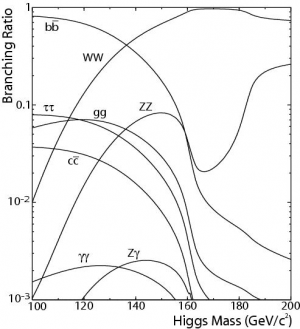
(Tomado de Flip Tanedo An Idiosyncratic Introduction to the Higgs)
Las colaboraciones ATLAS y CMS observan una partícula coherente con un bosón de Higgs.
El 4 de julio de 2012, los experimentos ATLAS y CMS presentaron sus resultados preliminares e la búsqueda del bosón de Higgs. Ambos experimentos observan una nueva partícula en la región de masas de entre 125-126 GeV.
Había claros signos de que una nueva partícula ha sido detectada con un nivel de confianza de 5-sigma y con una masas de ~126,5 GeV. Eran resultados preliminares pero ese pico en la gráfica no dejaba duda de que se estaba ante una nueva partícula que tenía, además, que ser un bosón. Dado que el análisis de datos había sido dirigido sobre la base de la física del bosón de Higgs, se tenía un indicio muy fuerte de que se estaba ante el hallazgo de esa partícula.
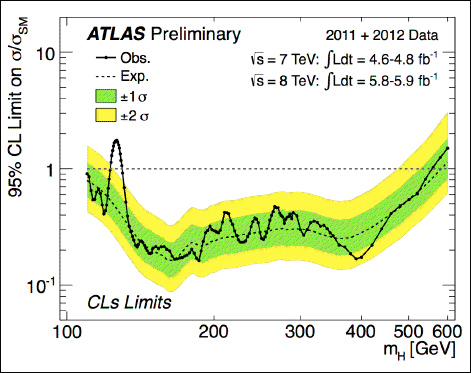
Image taken from ATLAS Website
El siguiente paso fue determinar la precisa naturaleza de esta partícula para saber si se trataba definitivamente del bosón de Higgs, siendo o formulado por el modelo estándar de la física de partículos, o algo más exótico.
Como se ha dicho antes, el bosón de Higgs se desintegras en partículas más ligeras: fotones, o mesones B, o leptones tao, o bosones W o Z. Desviaciones en la frecuenca de estos procesos pueden indicar que estamos fuera del modelo estándar. Podría incluso probarse que hay más de un tipo de Higgs.
Como es sabidos soloe el 4% de la materia existente es explicada por la física actual, por lo que encontrar una versión exótica del bosón de Higgs podría ser un puente hacia la compresión de ese universo que llamamos oscuro.
(Tomado en parte de CERN PRESS RELEASE - JULY 4th 2012)
Este resultado fue posteriormente confirmado en 2013.
Más sobre "significancia estadística"...
El bosón Higgs es conocido (debido al Nobel en Física Leon Lederman ) "la partícula divina" o "la partícula de dios" dada su importancia para o Modelo Estándar.
Lederman dijo que le dió ese nombre, "The God Particle", porque es crucial para comprender de verdad la estrutura del universo conocido según el modelo estándar, pero también añadió, y quizás aquí está la verdadeira razón de ese apelativo, que a su editor nonle gustó el primer nombre propuesto, "the Goddamn Particle", (la particula endemoniada), y propuso cambiarle el nombre por "The God Particle".
En cualquier caso, a muchos científicos no les gusta este nombre por las connotaciones religiosas que pueden derivarse, y prefieren llamarla "la partícula de la botella de champagne". La razón sería por la celebración que su descubrimento tendría en la comunidad de físicos, y también por la anécdota según la cual el físico David J. Miller ganó en 1993 una botella de champagne ofrecida por el ministro de Ciencia británico William Waldegrave a quien fuese capaz de explicarle que era el bosón de Higgs.
Estudiando la producción de di-Higgs.
Tratar de encontrar dos bosones de Higgs en el mismo lugar al mismo tiempo, lo que se conoce como producción de di-Higgs, este fascinante proceso puede informar a los científicos sobre la auto-interacción del bosón de Higgs.
Estudiándolo, los físicos pueden medir la fuerza del "autoacoplamiento" del bosón de Higgs, que es un aspecto fundamental del Modelo Estándar que conecta el mecanismo de Higgs y la estabilidad de nuestro universo.
Buscar la producción de di-Higgs es una tarea especialmente difícil. Es un proceso muy raro, unas 1.000 veces más raro que la producción de un solo bosón de Higgs. Durante todo el Run 2 del Gran Colisionador de Hadrones (LHC), sólo se espera que se hayan producido unos pocos miles de eventos di-Higgs en ATLAS, en comparación con los 40 millones de colisiones que se producen cada segundo.

Imagen de un evento candidato de producción de di-Higgs tomado en 2017. (Imagen: ATLAS collaboration/CERN)
ATLAS sondea la interacción del bosón de Higgs con los quark más pesados.
Con sus métodos de análisis actualizados, la colaboración ATLAS ha mejorado significativamente la precisión de sus mediciones de las interacciones del bosón de Higgs.
En la Conferencia Internacional de Física de Altas Energías (ICHEP) 2024, la colaboración ATLAS presentó medidas mejoradas de la fuerza de las interacciones del bosón de Higgs con los tres quarks más pesados: top, bottom y charm. Los resultados se basan en un nuevo análisis de los datos del LHC Run 2 tomados en los años 2015-2018 con métodos de análisis significativamente mejorados, incluyendo un mejor etiquetado de los jets de partículas.

Suceso candidato para el proceso ZH → μμ cc, en el que un bosón Z y un bosón de Higgs decaen en dos muones (líneas rojas) y dos jets charm-tagged (conos azules). (Imagen: colaboración ATLAS)
Los investigadores de ATLAS han puesto sus miras en los datos del LHC Run 3 en curso y en la próxima operación de alta luminosidad del LHC. Con estos datos, los físicos podrán observar por fin la esquiva producción de pares de bosones de Higgs.
Más aquí …
La partícula de Higgs: una analogía para la clase de Física.
Tomado de The Higgs particle: a useful analogy for physics classrooms.
Comparando el índice de refraccion y la masa.
Cuando la luz, compuesta por fotones, pasa a través de un material transparente como el vidrio, su velocidad cambia según el índice de refracción del material. Este cambio es debido a los campos eléctricos creados por el propio material, y pue incluso dar lugar a un cambio en la dirección en función del ángulo de incidencia.
Cuando los fotones pasan a través de un material como el aire, la interacción con los campos eléctricos de los átomos presentes es pequena y por tanto el cambio de velocidad o de dirección es también pequeña. Sin embargo, cuando el material es auga o vidrio la interacción es mayor y los fotones cambian sensiblemente de velocidad.
La reducción en la velocidad viene dada por el índice de refracción del material (i), de forma que la velocidad de la luz en ese medio viene dada por:
v = c/i
siendo c la velocidad de la luz en el vacío.
Un detalle muy importante es que el valor del índice de refracción varía ligeramente con la longitud de onda, y por tanto la velocidad también (y por tanto el momento do fotón). Por ejemplo, en el caso de la luz en el auga:
|
Azul (486.1 nm) |
Amarillo (589.3 nm) |
Rojo (656.3 nm) |
|
1.337 |
1.333 |
1.331 |
Así que, los fotones “amarillos” viajan más rápidos que los "azules", y los "rojos" son los más veloces. Podríamos decir que los azules tienen más problemas para moverse en el agua que los amarillos, y éstos que lo rojos. En este sentido es como si los fotones azules tiuviesen más "inercia" (más masa) que los amarillos, y éstos más que los rojos. El índice de refracción es una medida de la interaccón entre los fotones y el medio material, y por tanto puede ser considerado como un "índice de masa", dado que cuanto mayor es su valor menor es la velocidad de los fotones.
Tenemos pues que en el vacío todos los fotones se mueven con la misma velocidad, pero si en el universo apareciese de repente lleno de agua los fotones tendrían diferente velocidad según su longitud de onda. O visto de otra forma, los fotones tendrían diferente "masa". Estamos pasando de una situación simétrica (el vacío) a otra no simétrica. Esto es lo que en Fïsica de Partículas se conoce como rotura espontánea de simetría.
Estamos ahora en situación de llevar adelante la analogía. Inicialmente todas las partículas viajan en el universo con la máxima velocidade permitida. Por tanto non tienen "inercia", o dicho de otra forma todas tienen masa cero, y desde ese punto de vista el universo presenta total simetría. Esto es precisamente lo que establece el Modelo Estándar en principio, pero no es así como funciona el universo que conocemos. Las partículas tienen masas muy diferentes.
El Modelo Estándar reformado sugiere que en efecto las partículas poseían masa cero justo después del Big Bang, pero cuando la temperatura descendío por debajo de cierto valor, un campo "transparente" -el campo de Higgs- comenzó a mostrar su influencia. Este campo es igual en todas partes, pero el valor de la interacción entre las diferentes partículas con el es diferente según el tipo de partícula. La intensidad de esta interacción es la que le confiere masa a las partículas. Quarks y electrones resultan tener masas muy diferentes. Las otras interacciones -nuclear fuerte, débil, electromagnética- también contribuyen a las masas de las partículas en función de las cargas que presenten.
Supongamos quarks o electrones (como parte de otras partículas, como protones, núcleos, o átomos), moviéndose en el campo de Higgs. Sus interacciones con el campo genera diferentes inercias según la composción, y por tanto "origina" diferentes masas.
El campo de Higgs actúa como un “material transparente” con un "índice de masa" específico para cada clase de partícula fundamental. Ésto es lo que explica que para mover un electrón en reposo necesitemos unas 200 veces menos fuerza que un muón, o tomando el lenguaje mas clásico diremos que un muón tiene 200 veces más masa que un electrón.
Por tanto, este campo es el responsable de las diferentes masas observadas para las partículas y constituye el mecanismo de rotura de simetría que explica como funciona nuestro universo.
A pesar de las evidentes limitaciones de la analogía, la idea esencial radica en establecer el paralelismo entre l rotura de simetría cuando la luz viaja en un medio transparente y la rotura de simetría cuando las partículas viajan en el campo de Higgs.
Desde el punto de vista cuántico, ese campo puede entenderse formado por unidades discretas que llamamos partículas de Higgs. Dado que en el marco de la teoría deben tener spin entero pertenecerán a la familia de los bosones, y por tanto también son conocidos como Bosones de Higgs.
Como ya se ha dicho más arriba, las colaboraciones ATLAS y CMS announciaron su descubrimiento en CERN el 4 de julio de 2012. El resultado fue posteriormente reconfirmado en 2013.
|
AUTORES Xabier Cid Vidal, Doctor en Física de Partículas (experimental) por la Universidad de Santiago (USC). Research Fellow in experimental Particle Physics en el CERN, desde enero de 2013 a diciembre de 2015. Estuvo vinculado al Depto de Física de Partículas de la USC como becario "Juan de la Cierva", "Ramon y Cajal" (Spanish Postdoctoral Senior Grants), y Profesor Contratado Doctor. Desde 2023 es Profesor Titular de Universidad en ese Departamento (ORCID). Ramon Cid Manzano, catedrático de Fïsica y Química en el IES de SAR (Santiago - España), y Profesor Asociado en el Departamento de Didáctica de Ciencias Experimentales de la Facultad de Educación de la Universidad de Santiago (España), hasta su retiro en 2020. Es Licenciado en Física, Licenciado en Química, y Doctor por la Universidad de Santiago (USC).(ORCID). |
CERN |
LHC |
NOTA IMPORTANTE
Toda la Bibliografía que ha sido consultada para esta Sección está indicada en la Sección de Referencias
© Xabier Cid Vidal & Ramon Cid - rcid@lhc-closer.es | SANTIAGO (ESPAÑA) |





